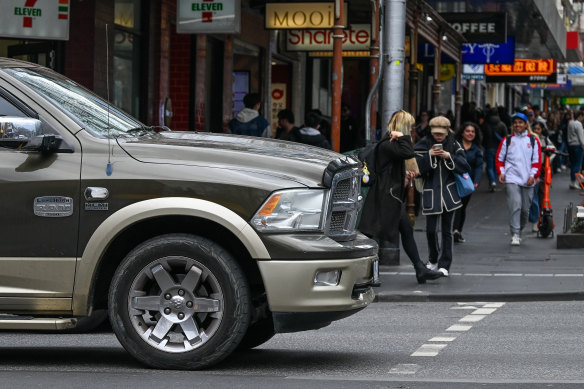This was published 1 year ago
Opinion
Hate all the monster utes on our streets? Your tax dollars helped pay for them
Shane Wright
Senior economics correspondentTake to the roads, any road, any time, and you’ll quickly see bad tax policy at work. While most of us work in offices and drive around nothing more dangerous than a suburban cul-de-sac, the army of large utilities is startling.
Of the 10 best-selling vehicles, five are mini-trucks masquerading as work vehicles. Led by Toyota’s ubiquitous HiLux and followed by Ford’s Ranger, for the past six years, the two top-selling vehicles in this country have been the two big utes.

A RAM truck stopped in Melbourne.Credit: Joe Armao
This surge in sales began in the wake of the Global Financial Crisis, when the Rudd government introduced a tax concession that enabled small businesses to immediately write-off assets like vehicles for tax purposes in a bid to get the economy through.
Ever since then, the write-off has been extended and increased in value, all to get businesses to bring forward their spending on new capital equipment. But like all tax concessions that seemed a good idea at the time, there is an unintended consequence.
During the depths of the pandemic, the Morrison government increased the maximum write-off to $150,000. And though the Albanese government has called time on this particular limit, this year’s budget still set a $20,000 threshold for the current financial year.
These tax concessions come at a cost to all of us. The $20,000 threshold, for instance, will result in taxpayers missing out on almost $700 million in revenue over the next two years. Over a longer period, this taxpayer subsidy is to the tune of billions of dollars.
Leaving the environmental impacts of these mega-vehicles aside, what’s clear and what is evident on any highway or throughout the narrow streets of any new build suburb, is that the nation’s new car owners have used the write-off to buy vehicles that are supposed to be primarily used for day-to-day shifting of power saws, drills and the like and turned them into the family transporter. That so many of these vehicles have four doors and include bullbars is evidence of how the write-off has been used to supplement the lifestyle choices of many Australians.
Earlier this month, Standards Australia opened comments for a proposal to increase the size of parking spaces, all due to the ever-increasing popularity of these cars.
In 2004, when the length of parking spaces was last reviewed by Standards Australia, SUVs made up about 13 per cent of the national fleet. Almost two decades on, that number has ballooned to 40 per cent.
A current parking space should be 5.4 metres long. Standards Australia wants to increase that by 20 centimetres. Though the difference in length may only seem trivial, in real terms it would increase the size by roughly 4 per cent. At a shopping centre like Fountain Gate in Melbourne’s south-east, that would mean losing about 255 existing spaces to make way for these new vehicles. In other words, there’ll either be fewer parking spots or we’ll have to put more money into more concrete and asphalt, all to accommodate bigger vehicles.
That’s before we even get to the extra weight of these behemoths and what that means for our growing number of multi-storey car parks.
The first car I ever drove was a Holden Kingswood ute. It was 4.8 metres long and weighed about 1.4 tonnes. A Ford Ranger, before the bullbar and tow-bar, is 5.4 metres long and weighs a tonne more than the old Holden. The Ram crew cab is 5.8 metres long and weighs 2.6 tonnes before it’s been fitted with a box of hammers.
From a cost-of-living perspective, there’s not much sense to be found, either. While a Toyota Corolla gives you about 4 litres per 100 kilometres, the HiLux guzzles 8.1 litres covering the same distance.
With the average Australian vehicle travelling 13,000 kilometres each year and petrol averaging $2.10 per litre, your annual petrol bill with a Corolla is roughly $1092. A HiLux is $2184.
The issue of our nation’s growing fleet holds extra resonance after the decision by the High Court to strike down Victoria’s electric vehicle tax.
Though there were always issues with Victoria deciding to tax electric cars when it is the federal government that collects excise on petrol, the federal government has dragged its feet for too long on an issue that has segued into some weird political dead ends.
In 2019, Scott Morrison accused Labor of declaring a war on the weekend with its EV policy and warned more EVs would hit the budget because they did not pay fuel excise. The Morrison government never did come up with its own policy to deal with what every budget and motoring expert knows, which is that as electric cars replace internal combustion engine vehicles, the annual excise on petrol and diesel (worth $22 billion this year) is set to disappear slowly.
Put together, taxpayers now have a federal government losing important revenue by giving a tax break to a select group of people to buy a vehicle that is forcing the country to change the way it parks, at the same time as one of its key cash sources (excise) shrivels up and dies, during a cost-of-living crisis.
Famously, the first Australian utes were produced in the 1930s after a farmer’s wife purportedly wrote to the company asking for a vehicle that she and her husband could drive to church on Sunday and carry pigs to market on Monday.
Today, you’d have to sell an awful lot of pigs to cover the cost we’ve imposed upon ourselves through stupid tax incentives on utes.
Shane Wright is a senior economics correspondent.
The Opinion newsletter is a weekly wrap of views that will challenge, champion and inform your own. Sign up here.